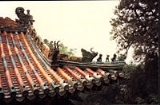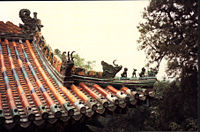
Glazed tile
Encyclopedia


China
Chinese civilization may refer to:* China for more general discussion of the country.* Chinese culture* Greater China, the transnational community of ethnic Chinese.* History of China* Sinosphere, the area historically affected by Chinese culture...
since the Zhou Dynasty
Zhou Dynasty
The Zhou Dynasty was a Chinese dynasty that followed the Shang Dynasty and preceded the Qin Dynasty. Although the Zhou Dynasty lasted longer than any other dynasty in Chinese history, the actual political and military control of China by the Ji family lasted only until 771 BC, a period known as...
as building material for roof top. During the Song Dynasty, the manufacture of glazed tiles was standardized in Li Jie
Li Jie
Li Jie is a Chinese classical guitar virtuosa.-Biography:She began studying the classical guitar at the age of 11 under Professor Chen Zhi . One year later, she appeared as a performer on the television program "Classical Guitar's Technique and Performance" of China's official national television...
's Architecture Standard
Yingzao Fashi
The Yingzao Fashi is a technical treatise on architecture and craftsmanship written by the Chinese author Li Jie , the Directorate of Buildings and Construction during the mid Song Dynasty of China. A promising architect, he revised many older treatises on architecture from 1097 to 1100...
. In the Ming Dynasty
Ming Dynasty
The Ming Dynasty, also Empire of the Great Ming, was the ruling dynasty of China from 1368 to 1644, following the collapse of the Mongol-led Yuan Dynasty. The Ming, "one of the greatest eras of orderly government and social stability in human history", was the last dynasty in China ruled by ethnic...
and Qing Dynasty
Qing Dynasty
The Qing Dynasty was the last dynasty of China, ruling from 1644 to 1912 with a brief, abortive restoration in 1917. It was preceded by the Ming Dynasty and followed by the Republic of China....
, glazed tiles became ever more popular for top tier buildings, including palace halls in the Forbidden City
Forbidden City
The Forbidden City was the Chinese imperial palace from the Ming Dynasty to the end of the Qing Dynasty. It is located in the middle of Beijing, China, and now houses the Palace Museum...
, and ceremonial temples (for example the Heavenly Temple).
There are two main types of Chinese glazed tiles: glazed tubular tile and glazed plate tile. Glazed tubular tiles are moulded into tube shape on a wooden mould, then cut in two halves along their length into two tubular tiles, each semicircular in shape. A tube shape clay mould can be cut into four equal parts, with a cross section of a quarter of a circle, then glazed into a four plate tire.
Glazed plate tiles are laid side by side across and overlapping on each other. In the Song Dynasty, the standard for overlap was 40% overlap, and was increased to 70% overlap in the Qing dynasty. With the Song style 40% overlap, it was not possible to have triple tile overlap, there was a 20% gap between the first plate tile and the third plate tile. Hence, if a crack developed in the second tile, water leak was inevitable. One the other hand, with the Qing dynasty style 70% overlapping, the first plate tile was overlapped 70%, 40% and 10% by the second, third and fourth tile respectively; thus even if the second and/or the third tile developed cracks, there would be no rain leakage.
Glazed tubular tiles used at the eave edge are called eaves edge tubular tiles. They have an outer end made into a round shape top, often moulded with the pattern of dragon. Eave edge plate tiles have their outer edge decorated with a triangular shape end to facilitate rain fall.

